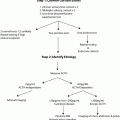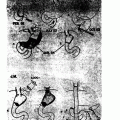Paul Wermer. (From [14]. Reprinted with permission from ABC-CLIO Inc)
Paul Wermer , son of Leopold Wermer and Sophie nee Goldsterm, was born on February 3, 1898, in Vienna, Austria, and died on November 18, 1975, in Europe. He married Eva Raundnitz in 1925 and had a son, Hans Wermer. His native language was Hungarian.
Dr. Wermer studied at the faculty of medicine from the summer of 1918 throughout the winter semester of 1921 [1]. During his final semester, he studied at the University of Heidelberg, passed his final exams with honors, and obtained his medical degree from the medical school of the University of Vienna in 1922 [2]. For further education, Dr. Wermer moved to Ann Arbor, Michigan, obtaining the degree of Endocrine Physiologist from Michigan University in 1933. He then moved to New York in 1942 to do research in the Department of Medicine of Columbia University. He was part of the College of Physicians and Surgeons from 1947 to 1963 [3].
Paul Wermer participated in research projects in many hospitals (Fig. 1), including the Vanderbilt Clinic, the Delafield Hospital, the Bellevue Hospital, and the Presbyterian Hospital. With the aim of providing an appropriate forum for educational and disseminating the results of his biological research, Dr. Paul Wermer joined the Federation of American Societies for Experimental Biology in 1954 [3]. He retired from professional life on June 30, 1963 [2].


Fig. 1
Paul Wermer’s employee card at Columbia University
A constellation of multiple endocrine tumors was first reported by Jakob Erdheim in 1903. He described the autopsy of a patient with acromegaly, a pituitary tumor, thyroid goiter, three enlarged parathyroid glands , and pancreatic necrosis [4]. There were several reports of patients with multiple endocrine tumors to follow, but a true syndrome was not identified until 1953. Underhal and others from the Mayo Clinic reported eight patients with multiple endocrine adenomas that included parathyroid tumors in all, acromegaly in two, and severe peptic ulcer disease due to Zollinger–Ellison syndrome (ZES) in 3 [5].
Dr. Wermer wrote several papers in the field of endocrine disease. Perhaps his most relevant contribution was his description of the “Genetic Aspects of Adenomatosis of the Endocrine Glands,” which was published in the American Journal of Medicine in 1954. In this publication, he described what is known today as the multiple endocrine neoplasia type 1 (MEN-1), a syndrome that includes pituitary, pancreatic, and parathyroid tumors and that was subsequently named after him (Wermer syndrome) . In his paper, he described a family in which the MEN-1 syndrome occurred in several family members spanning two generations. In his conclusions, he highlighted the hereditary pattern of the syndrome as autosomal dominant suggesting that one single autosomal gene would be responsible for the disease. This hypothesis was later confirmed with the discovery of the menin gene at 11q13 [6, 7].
Stay updated, free articles. Join our Telegram channel

Full access? Get Clinical Tree







